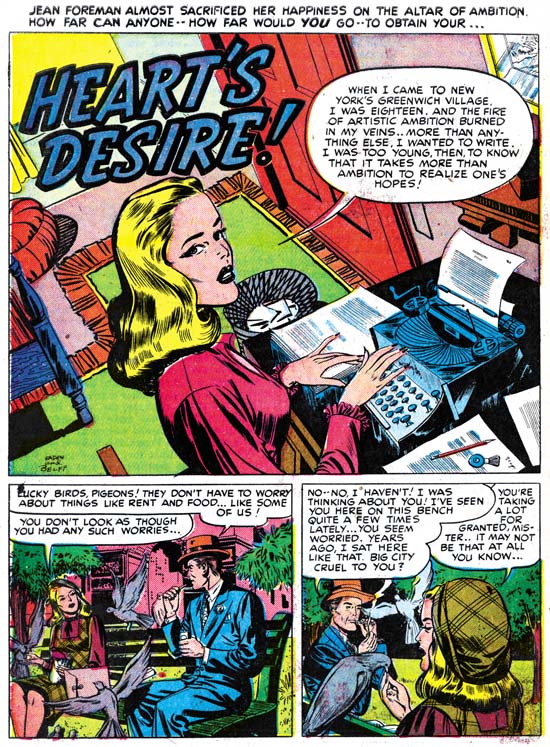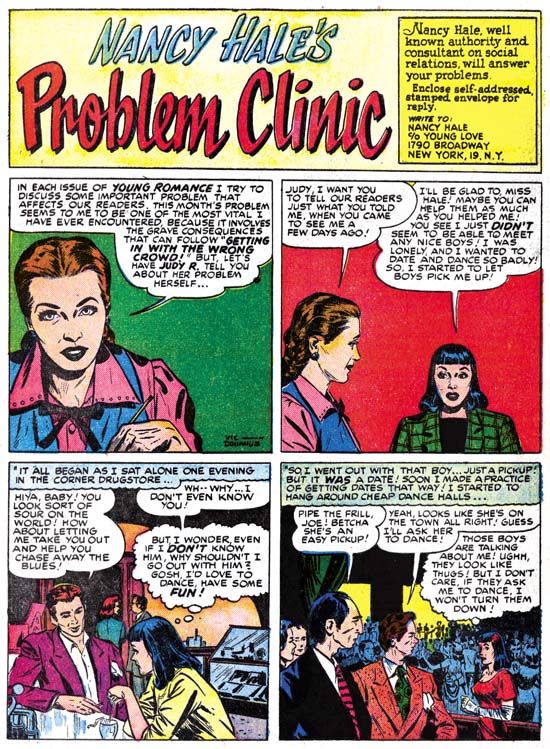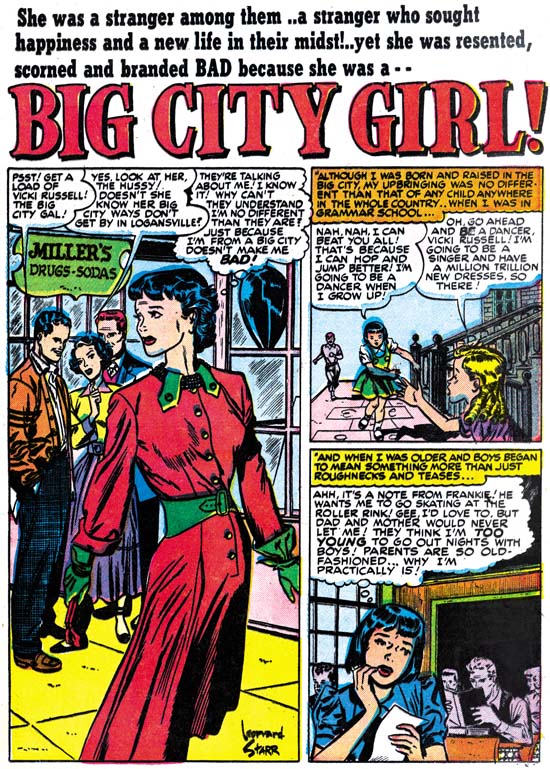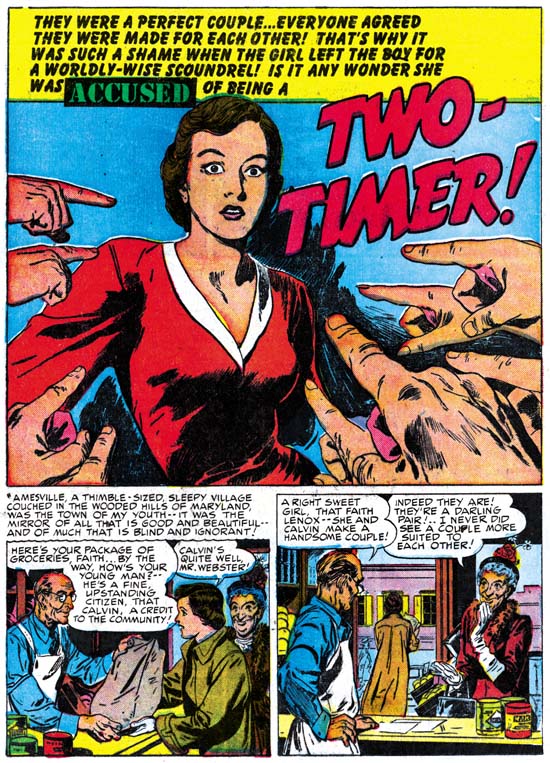(Young Romance #9 – #12, Young Love #1 – #4)

Young Romance #12 (July 1949) “The Man I Kept on a String”, art by Bill Draut
As discussed in the previous chapter, Bill Draut became the most prolific contributor to the Simon and Kirby romance titles within the period from Young Romance #9 (January 1949) through Young Love #4 (August 1949). Bill’s importance is also shown by the fact that for the first time a couple feature stories would be done by someone other then Jack Kirby. However with one exception (“The Plumber and Me” from Young Love #1) Bill’s stories would not be as lengthy as Jack’s would sometimes be. This is true even when it was the featured story which so far Jack had always made the longest in the comic. This was the case with “The Man I Kept on a String” which despite being the feature story is just 8 pages long. Bill’s splash for this feature story continued to use the device of a word balloon for the introduction caption and title. Was Bill just told to do this or was he supplied a layout? I just do not have a good answer to that question. The layout of this splash is unusual in having four story panels in two rows with the splash panel assuming an inverted L shape. Since that arrangement is not found in any other splashes drawn either by Bill or Jack it does not provide any suggestion as to who laid it out. Also not found in other splashes is the use of the diminished statue of the one of the figures as a visual symbol of his status. Although at this time I cannot decide on who should be credited for laying out the splash, I find the rest of these stories, and the others that Bill did during this period, to be told in his own manner and therefore not based on layouts provided by Joe or Jack.

Young Love #1 (February 1949) “Lady Luck”, art by Bill Draut
Since Draut had such an outstanding presence during this period, I though I would include another example of his work. The splash has an interesting design using a card of an ace of spades as a visual link to the title and theme of “Lady Luck”. The background for the splash panel is very unusual and I have to admit I really cannot make out what it is supposed to represent. Most splashes by Draut do not have such an emphasis on design. Again I am undecided in splashes such as “Lady Luck”, where design is so important, whether the layout was supplied to Bill or not. Before leaving this story I would like to point out the way Bill presents the adoring Ruth in the last panel of the page. This particular upward gaze with the head slightly tilted was another of those trademarks of Bill Draut.
This period marks a change in Bill’s art work, although I am not certain what if anything can be made of it. The story “Shadows” (Young Romance #10 from March 1949) would be the last work for Simon and Kirby that Bill would sign. Previous his signatures appeared on a good fraction of his work but it would never again be used for anything else Bill did for S&K productions. I am only familiar with very little of Draut’s work after the Simon and Kirby studio closed but I have never seen a signature on any of it either.

Young Romance #10 (March 1949) “Heart’s Desire”, art by Al Eadeh and John Belfi
Draut’s higher productivity during the period helped to offset Kirby’s declining presence but it was not enough to make up for it entirely. Especially since the team of Jerry Robinson and Mort Meskin were no longer contributing either. New artists, at least new for the Simon and Kirby studio, began to provide romance stories. The most important for this period may have been the team of Al Eadeh and John Belfi. Assuming I am correct in my attributions (only 2 of them were signed) Eadeh and Belfi provided 6 stories. The usual assumption in teams like this is that the first name of the signature is the penciler and the second the inker. It should be kept in mind that the division of labor was not always so complete, as for example with Robinson and Meskin where Meskin’s presence seems more then in just the inking. However Eadeh and Belfi divided up their work the same inking style was used even for the unsigned stories that I credit to them. Eadeh and Belfi’s art is not very distinctive but there are some features that help in identifying their work. Light haired woman have thin lines that do not suggest waves and curls very sensuously; often the lines of hair are almost straight even when doing a curl. The outlines for long hair vary in thickness along its length. Some men have distinctively shaped thick eyebrows.
The splash for “Heart’s Desire” has an interesting high and tilting viewpoint. This is not at all typical of their work for either splashes or the stories. I am not sure why they adopted this tilt in this case. It does allow the title and the woman’s confession to occupy the top of the panel leaving the rest with an unobstructed view. In any case it serves to make the image more interesting. I feel that the artists that did work for Simon and Kirby were usually the better ones in the business and that includes Eadeh and Belfi. They certain provided professionally done work and knew how to graphically tell a story. I do have to admit though that they really are not among my favorite S&K artists. Al Eadeh is probably best known for work he did for Timely/Atlas. John Belfi seemed to have worked for a number of outfits sometimes as penciler and other times as inker. Both Eadeh and Belfi are included in David Hajdu’s lengthy list in “The Ten-Cent Plague” of artists who did not continue working in comics “after the purge of the 1950s”.

Young Love #2 (April 1949) “Nancy Hale’s Problem Clinic”, art by Vic Donahue
Another new artist for the S&K romance comics was Vic Donahue. During this period Vic would draw four of “Nancy Hale’s Problem Clinic” a short feature, usually 2 or 3 pages long, that appeared in both Young Romance and Young Love. Although Donahue was new to the romance titles his work had previously appeared in S&K crime comics starting with Headline #32 (October 1948). Vic would be associated with Simon and Kirby for a period of about three years but he never seemed to achieve much prominence in their productions. Sometimes Vic signed with his full name with a distinctive long line after the “Vic”, other times he would only use his first name but kept that long line. Donahue can best be recognized by his attractive but not overly beautiful woman. The slight tilt of Nancy Hale’s head in the first panel above shows up from time to time in Donahue’s women. It appears that, like most S&K studio artists, Vic generally did his own inking. Much attention was paid by Donahue in the rendering of hair. At times Vic used a pen to shadow an area with very straight fine lines as can be seen on Nancy Hale’s hand in the first panel of the image above. Donahue also occasionally used picket fence crosshatching or indicate shade by strong simple hatching with a brush. While both of those techniques are typical of the Studio style of inking, Vic did not use any other brush methods from that style.
There is one interesting exception to Vic Donahue as only an artist for the Nancy Hale feature during this period and that is the featured story for Young Love #4, “In Love with a Memory”. Jack Kirby penciled and inked the splash panel while Donahue drew and inked the bottom two panels as well as the rest of the story. The story matches Vic’s Nancy Hale work and does not seem to be based on Kirby layouts.

Young Romance #11 (May 1949) “Big City Girl”, art by Leonard Starr
A number of individuals did work for Simon and Kirby who would go on to become famous comic artists. I am not saying Joe and Jack discovered these artists but they did seem to recognized talent even during its early stages of emergence. One of these is certainly Leonard Starr. Leonard only appears in one story for the romance comics that I am covering in this post but was also appearing at this time in the western romances that I will be covering in a separate chapter. The first page for “Big City Girl” is laid out with a vertical splash with two story panels on the right side. This is not a splash page layout that Jack used at this time so once again I do not believe Joe or Jack did layouts for this story. Starr is good with his visual story telling and his woman are attractive but neither compares with what would come later when in 1957 when Starr create his syndication strip On Stage (later called Mary Perkins On Stage). That strip is currently being reprinted.

Young Love #4 (August 1949) “My Strange Fear”, art by George Gregg
An unexpected benefit of preparing for this blog post was the detecting of a signature that I had previously overlooked. There on a book spine of the splash for “My Strange Fear” is the name Gregg. I had already seen a similar signature on a story from Justice Traps the Guilty #17 (August 1950) “Best Seller” but I was never able to make out the correct spelling. The signature in “My Strange Fear” is very clear and I am certain that the artist must be George Gregg. Since this is a very recent discovery for me, I do not yet know how much a part Gregg will have in Simon and Kirby productions but since his other signed work is from a year after “My Strange Fear” there is a good chance more work will be found. Some of the eyebrows are very distinctive in “My Strange Fear” so it should not be hard to recognize George’s work even when a signature is lacking. Gregg is another of those artists found on Hajdu’s list of the ’50s purge victims.

Young Love #4 (August 1949) “Two-Timer”, art by Bruno Premiani?
What can I say, sometimes I make mistakes. I had previously included “Two-Timer” in a post about John Prentice as the first work that he did for Simon and Kirby. At that time I recognized that the style was not typical of Prentice but felt that he had not yet matured into his final style. Later I came to realize that there was a body of work from August 1949 through October 1950 that was pretty consistent and distinct from John Prentice’s work which would not appear in Simon and Kirby productions until April 1951. Unfortunately none of the art by this earlier artist for Simon and Kirby was ever signed. Two stories by this artist were reprinted in “Real Love” where they were credited to Bruno Premiani. I do not know whether this was by Richard Howell, the editor of that book, or either Mark Evanier or Greg Theakston who are credited with supplying information. Nor do I know what formed the basis of that attribution. Because in cases such as this my motto is trust but verify, I have given some cursory examinations of some other comics attributed by Permiani, Tomahawk and Doom Patrol. Frankly nothing I saw convinced me that they were by the same artist. The material for DC is distinctly simpler, with much sparser inking, and the eyebrows of women are more arched. There are artists that adapt their style in relationship to the subject or genre they are working in and perhaps that is the case here. There is an excellent biography of Bruno Permiani which indicates that Bruno, born in Italy but had immigrated to Argentina, was in the U.S. during this time. For now I will be using the Premiani attribution but with a question mark to indicate my personal uncertainty.
Whether he is was truly Bruno Permiani or not, I have come to admire this studio artist greatly. Premiani only did work for Simon and Kirby for a little over a year but he contributes a fair amount of material (20 stories by my count). Bruno works in an illustrative style similar to that of John Prentice (hence my original confusion). The two can most easily be distinguished by their women; those by Prentice have a sophisticated beauty with slightly longer faces while Permiani’s women, although still attractive, are somewhat plainer with relatively straight eyebrows. Bruno had an ability to truly animate his subjects. Without using excessive poses or melodramatic rendering, Premiani’s people just seem to radiate their emotions.
I have not commented on every individual cover or story in this serial post; however I review everything for the titles belonging to a particular chapter. I try to remark on any of my attributions that might be different from credits supplied by other scholars, particularly the Jack Kirby Checklist. For those who are interested in my attributions of work not included in the serial post itself, I have added checklists for Young Romance and Young Love to the sidebar. I will be expanding these lists as new chapters The Art of Romance appear. I would prefer any comments about my attributions to be placed in the chapters of The Art of Romance where they are less likely to be overlooked.
Chapter 1, A New Genre (YR #1 – #4)
Chapter 2, Early Artists (YR #1 – #4)
Chapter 3, The Field No Longer Their’s Alone (YR #5 – #8)
Chapter 4, An Explosion of Romance (YR #9 – #12, YL #1 – #4)
Chapter 5, New Talent (YR #9 – 12, YL #1 – #4)
Chapter 6, Love on the Range (RWR #1 – #7, WL #1 – #6)
Chapter 7, More Love on the Range (RWR #1 – #7, WL #1 – #6)
Chapter 8, Kirby on the Range? (RWR #1 – #7, WL #1 – #6)
Chapter 9, More Romance (YR #13 – #16, YL #5 – #6)
Chapter 10, The Peak of the Love Glut (YR #17 – #20, YL #7 – #8)
Chapter 11, After the Glut (YR #21 – #23, YL #9 – #10)
Chapter 12, A Smaller Studio (YR #24 – #26, YL #12 – #14)
Chapter 13, Romance Bottoms Out (YR #27 – #29, YL #15 – #17)
Chapter 14, The Third Suspect (YR #30 – #32, YL #18 – #20)
Chapter 15, The Action of Romance (YR #33 – #35, YL #21 – #23)
Chapter 16, Someone Old and Someone New (YR #36 – #38, YL #24 – #26)
Chapter 17, The Assistant (YR #39 – #41, YL #27 – #29)
Chapter 18, Meskin Takes Over (YR #42 – #44, YL #30 – #32)
Chapter 19, More Artists (YR #45 – #47, YL #33 – #35)
Chapter 20, Romance Still Matters (YR #48 – #50, YL #36 – #38, YB #1)
Chapter 21, Roussos Messes Up (YR #51 – #53, YL #39 – #41, YB #2 – 3)
Chapter 22, He’s the Man (YR #54 – #56, YL #42 – #44, YB #4)
Chapter 23, New Ways of Doing Things (YR #57 – #59, YL #45 – #47, YB #5 – #6)
Chapter 24, A New Artist (YR #60 – #62, YL #48 – #50, YB #7 – #8)
Chapter 25, More New Faces (YR #63 – #65, YLe #51 – #53, YB #9 – #11)
Chapter 26, Goodbye Jack (YR #66 – #68, YL #54 – #56, YB #12 – #14)
Chapter 27, The Return of Mort (YR #69 – #71, YL #57 – #59, YB #15 – #17)
Chapter 28, A Glut of Artists (YR #72 – #74, YL #60 – #62, YB #18 & #19, IL #1 & #2)
Chapter 29, Trouble Begins (YR #75 – #77, YL #63 – #65, YB #20 – #22, IL #3 – #5)
Chapter 30, Transition (YR #78 – #80, YL #66 – #68, YBs #23 – #25, IL #6, ILY #7)
Chapter 30, Appendix (YB #23)
Chapter 31, Kirby, Kirby and More Kirby (YR #81 – #82, YL #69 – #70, YB #26 – #27)
Chapter 32, The Kirby Beat Goes On (YR #83 – #84, YL #71 – #72, YB #28 – #29)
Chapter 33, End of an Era (YR #85 – #87, YL #73, YB #30, AFL #1)
Chapter 34, A New Prize Title (YR #88 – #91, AFL #2 – #5, PL #1 – #2)
Chapter 35, Settling In ( YR #92 – #94, AFL #6 – #8, PL #3 – #5)
Appendix, J.O. Is Joe Orlando
Chapter 36, More Kirby (YR #95 – #97, AFL #9 – #11, PL #6 – #8)
Chapter 37, Some Surprises (YR #98 – #100, AFL #12 – #14, PL #9 – #11)
Chapter 38, All Things Must End (YR #101 – #103, AFL #15 – #17, PL #12 – #14)

